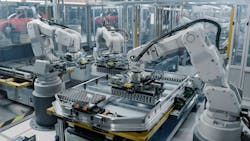Fully autonomous, lights-out operations: Are the future plant and factory floors run by machines without humans?
Key takeaways:
- Understanding which industries are leading in autonomy—like automotive, semiconductors, and energy—helps controls engineers benchmark their own systems and identify where automation investments may yield the most impact.
- Flexible, intelligent systems and low-code robotics programming platforms are influencing how control systems will be designed and deployed in the near future.
- Autonomy challenges such as product variability, infrastructure flexibility, and real-time decision-making highlight where engineering innovation is still needed.
Industry is making strides toward fully autonomous operations, but generally in most sectors human oversight is still necessary. “Industries such as automotive manufacturing are closest to achieving full autonomy, leveraging robotics, software-based quality control and high level of standardization,” says Alessandro Piscioneri, head of products and solutions management at Comau.
Logistics and warehousing are another big growth area, but the product variability presents additional complexity. “Challenges remain in flexible decision-making, adaptability to unpredictable scenarios and complex assembly tasks,” Piscioneri adds. “Future advancements in AI-driven process optimization, advanced machine vision systems, cybersecurity and real-time sensor fusion will be key to making fully autonomous manufacturing a reality.”
To that end, Comau is collaborating with software company Intrinsic to develop and make scalable operations easier with pre-configured application templates. The AI-backed software will power intelligent decision-making and help deploy this kind of advanced technology at a faster pace.
“The software platform, equipped with a low-code graphical interface, enhances robotics adoption and cost-effectiveness by helping companies in various industries access modern automation solutions. It simplifies robot programming, making it intuitive for non-experts, particularly in industries approaching automation for the first time,” Piscioneri says.
How to turn machine automation into plant- or factory-wide autonomy
Considering automation in the scope of an individual production line, some industries are close to fully automatic production with no humans, says André Scholz, head of innovation department: autonomous factory, at Siemens. “Industry is far away from fully autonomous operations if we include service, maintenance and new product introduction into the operations of a factory,” he says.
Full autonomy has two prerequisites before industry can fully realize a factory with no humans, Scholz says. Facilities need process flexibility to allow production to be done in different ways, such as a robot handling product, instead of a fixed machine.
The other necessity is intelligence. “An intelligent system that can understand the current situation—for example, an error in one part of the production system—and find alternative ways to reach the goal of production—for example, usage of other parts or other station—is essential to make this a reality,” says Scholz. “Some matrix production lines in automotive are quite close in aspects of flexibility and intelligence.” Again, individual processes or even production lines are an autonomous reality, but entire operations, factories or plants operating in sync requires not only more intelligent systems, but also better-connected machine data to power that intelligence.
Autonomous exploration, production and refining is next for the energy industry
Pal Roach, senior principal industry consultant for oil and gas at Rockwell Automation says the energy industry has invested heavily in industrial automation for more than 50 years. The industry is capital-intensive, with dangerous processes and harsh environments, and recently, Roach says, those customers have accelerated automation projects. “Autonomous operations in the energy industry today encompass various applications, including robotic inspections, drone-based monitoring and AI-powered predictive maintenance, aimed at improving safety, efficiency and productivity,” Roach says.
Joe Biondo, strategic marketing manager for OEMs and machine builders at Rockwell Automation, says those autonomous operations are the low-hanging fruit for the energy industry. “The next tier of opportunities is significantly more challenging, such as oil and gas exploration, oil and gas production, and petroleum refining,” Biondo says. “This will involve integrated sensing, measurement, control and optimization, all informed by the underlying physics and chemical engineering of the processes being controlled.”
A joint venture between Rockwell and oil and gas technology provider Schlumberger (SLB) formed Sensia, an automation provider for oil and gas, to build autonomous operations for various types of facilities. “Implementations available today include artificial lift oil production and digital well pad operations. Continued advancements in information technology, computer performance, connectivity, AI and wider adoption of open standards will accelerate the development of more solutions,” Biondo says.
Get your subscription to Control Design’s daily newsletter.
Semiconductor fabs lead the autonomous journey
The facilities that build our most advanced digital technologies, which power all our electronics, are also highly advanced manufacturing processes and largely autonomous.
“We’re still a ways from total lights-out factories where machines run entirely unsupervised, at least for most industries,” says Andrew Borczak, industry marketing manager, Omron. “The closest may be semiconductor fabs, where ultra-precise, highly automated environments require minimal human intervention with real-time monitoring and autonomous process control.”
While the industry has made significant advancements, fully autonomous operations remain a distant goal due to challenges in adaptability, decision-making and real-time optimization, says Cliff Ortmeyer, head of solutions at Newark. “The semiconductor industry is currently the closest to achieving autonomy, with highly controlled fabrication environments enabling limited self-correction and optimization,” he says. “Automotive assembly follows, driven by heavy investments in connected systems and predictive analytics.”
Product variability and infrastructure flexibility are the current hang ups to autonomy
Continuous automation is easier for consistent products like feeding systems and scales, says Greg Berguig, president of PAC Machinery, but more challenging for varied products like e-commerce packaging. “It’s just about getting faster and more flexible. Where I think the opportunity lies is in processes that have a lot of variability of product,” he adds. He points to the kitting process or e-commerce and packaging operations. “Once you get the item into the package, that’s super easy to automate from a packaging standpoint. It’s about getting that item into the package when you have variability.” The packaging industry has largely automated what we do with packages after they are filled, but complete autonomy in building products and packaging them remains the challenge and the next steps.
Next steps for controls engineers:
- Evaluate current control architectures to determine their readiness for integration with AI-driven decision-making and flexible process adaptation.
- Research low-code or other robotics programming tools to streamline automation deployment and empower less specialized personnel.
- Initiate pilot projects in areas with repetitive processes or limited variability to build experience with semi-autonomous operations and scale learnings.
About the Author
Anna Townshend
Managing Editor
Anna Townshend has been a writer and journalist for 20 years. Previously, she was the editor of Marina Dock Age and International Dredging Review, until she joined Endeavor Business Media in June 2020. She is the managing editor of Control Design and Plant Services.

Leaders relevant to this article:

